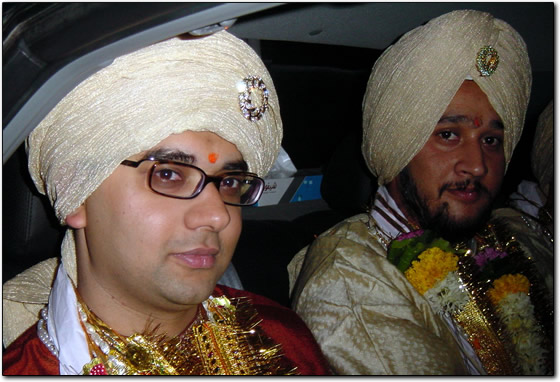
Mehndi
Back at the wedding, the baptism was completed, so the proper festivities could start. The “mehndi” is a party held separately by each of the bride and the groom. For Tanya's, only a few of Rahul's family and friends (and not Rahul himself, although he did put in a brief appearance) were invited, but since we knew Tanya, we were also invited to come. Strangely, the bride and groom sides of the families do not mix until the day of the wedding ceremony. During the mehndi, an all-afternoon and evening affair, the bride (or groom's) hands and feet are painted with henna, followed by food, singing and dancing. When we arrived, the dancing was just getting started. Everyone wanted to dance, especially the older folks, and they insisted that we join them. One small boy danced around like he was in a Bollywood film, demonstrating natural showmanship as well as some slick moves. Then the music was turned down and the guests formed a circle to chant and sing traditional songs accompanied by the harmonium, a small, pumped, one-handed piano. It turns out that Tanya has a few Kashmiri folk singers with excellent voices in her family. We were mesmerized by the beautiful, pure singing of one particular lady, and wanted to stay as long as possible. The younger generation was bored: “they always want to sit around and sing those old folk songs - we want to go out and dance!”
 |
 |
Rahul's mehndi was the next day. In the early afternoon the henna-painters arrived and the ladies crowded around to get their hands colored. Anne had a henna decoration painted on her neck. The other ladies wore their finest clothes and jewels, but Anne only had a borrowed sari. As time went on we noticed that no woman would wear the same sari more than once, and for each ceremony there was a whole new outfit down to the shoes and matching jewelry. Later that evening, after the guests had arrived, Rahul's family put on a synchronized dance performance to a medley of famous Bollywood songs. This was also the first function to serve meat. During the baptism only vegetarian Kashmiri dishes had been served: tasty, for sure, but with Rahul's father lauding the culinary delights of Kashmir, we were eager to taste the special dishes in store. Earlier in the day we had walked past the kitchen, where a giant pile of mutton was being cut and prepared for cooking. It was a long wait until dinnertime, but it was worth it. The food, served in huge portions, was marvelous. Piles of dried morels, a Kashmiri specialty, had been cooked with rice. An argument ensued when some of the guests insisted that they were not mushrooms. Another Kashmiri specialty, mincemeat balls with dried apricots, was served with a delicious gravy. Here also was a lesson in the cultural and culinary differences of different Indian people: the Gujaratis, even though they only ate the available vegetarian food, were not accustomed to the rich, oily Kashmiri dishes.
 |
